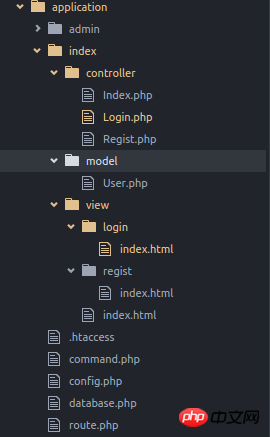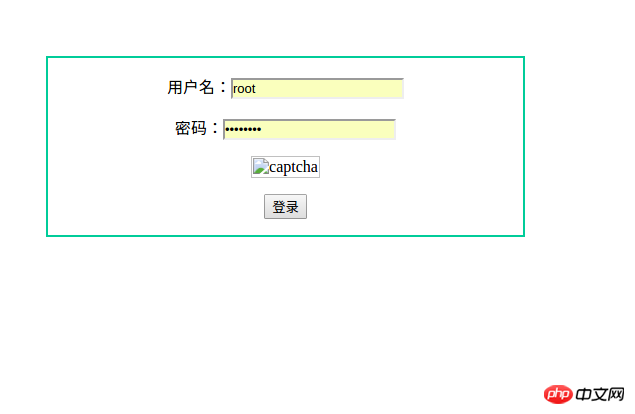 Backend Development
Backend Development
 PHP Tutorial
PHP Tutorial
 ThinkPHP5 development (1) Detailed explanation of the login function (picture)
ThinkPHP5 development (1) Detailed explanation of the login function (picture)
ThinkPHP5 development (1) Detailed explanation of the login function (picture)
Mainly start from these three aspects:
Database
PHP code
HTML code&ThinkPHP view template code
The database uses mysql5 .7. And use the latest version of PHP PHP7, apache2.4, Ubuntu16.04
Preparation:
Download the thinkphp5 code, put it in the apache directory, and grant 777 permissions
chmod 777 -R tp5/
Open your project using atom or sublime or PhpStorm and prepare for coding
Database thinkphp5
-- phpMyAdmin SQL Dump -- version 4.4.15.5 -- http://www.phpmyadmin.net -- -- Host: localhost -- Generation Time: 2016-07-06 20:42:33 -- 服务器版本: 5.7.12-log -- PHP Version: 7.0.7 SET SQL_MODE = "NO_AUTO_VALUE_ON_ZERO"; SET time_zone = "+00:00"; /*!40101 SET @OLD_CHARACTER_SET_CLIENT=@@CHARACTER_SET_CLIENT */; /*!40101 SET @OLD_CHARACTER_SET_RESULTS=@@CHARACTER_SET_RESULTS */; /*!40101 SET @OLD_COLLATION_CONNECTION=@@COLLATION_CONNECTION */; /*!40101 SET NAMES utf8mb4 */; -- -- Database: `thinkphp5` -- -- -------------------------------------------------------- -- -- 表的结构 `think_user` -- CREATE TABLE IF NOT EXISTS `think_user` ( `user_id` int(11) NOT NULL, `user_name` varchar(255) NOT NULL, `UserSex` int(11) DEFAULT NULL, `UserTel` varchar(255) DEFAULT NULL, `UserEmail` varchar(255) DEFAULT NULL, `UserAddress` varchar(255) DEFAULT NULL, `UserBirth` varchar(255) DEFAULT NULL, `UserJoinTime` varchar(255) DEFAULT NULL, `UserPasswd` varchar(255) DEFAULT NULL, `UserSignature` varchar(255) DEFAULT NULL, `UserHobby` varchar(255) DEFAULT NULL ) ENGINE=InnoDB DEFAULT CHARSET=utf8mb4; -- -- 转存表中的数据 `think_user` -- INSERT INTO `think_user` (`user_id`, ` user_name`, ` UserSex`, `UserTel`, ` UserEmail`, ` UserAddress`, ` UserBirth`, ` UserJoinTime`, ` UserPasswd`, ` UserSignature`, ` UserHobby`) VALUES (0, 'thinkphp', 1, '15700000000', 'emial@email.com', '山东省济南市****路', '1111111', '111111', 'qqq', NULL, NULL); -- -- Indexes for dumped tables -- -- -- Indexes for table `think_user` -- ALTER TABLE `think_user` ADD PRIMARY KEY (`user_id`); /*!40101 SET CHARACTER_SET_CLIENT=@OLD_CHARACTER_SET_CLIENT */; /*!40101 SET CHARACTER_SET_RESULTS=@OLD_CHARACTER_SET_RESULTS */; /*!40101 SET COLLATION_CONNECTION=@OLD_COLLATION_CONNECTION */;
First set up the framework, run it, and then enhance it.
2. Write PHP code according to the thinkphp5 manual on "Looking at the Cloud"
Here you can directly use the script provided by ThinkPHP5 that can directly generate code, or you can manually create a directory and file
applicationDirectory Structure 
Login.php
<?php
namespace app\index\controller;
use think\View;
use think\Controller;
use app\index\model\User;
/**
*
*/
class login extends Controller{
public function index(){
$view = new View();
return $view->fetch('index');
}
public function login($user_name='',$user_passwd=''){
$user = User::get([
'user_name' => $user_name,
'UserPasswd' => $user_passwd
]);
if($user){
echo '登录成功'.$user_name.md5($user_passwd);
}else{
return $this->error('登录失败');
}
}
}User.php
<?php
namespace app\index\model;
use think\Model;
class User extends Model{
protected $pk = 'user_id';//设置主键}3 . View code HTML
Use native HTML, CSS does not use the front-end framework
Rendering: 
login/index.html
<!DOCTYPE>
<html>
<head>
<title>登录</title>
</head>
<style>
dl{
text-align:center;
border:2px solid #00CC99;
margin-top:100px;
margin-bottom:100px;
margin-right:400px;
margin-left:400px;
}
</style>
<body>
<p id="login_form">
<form action="login" method="post">
<dl>
<dt>
<p>用户名:<input type="text" name="user_name"></p>
</dt>
<dt>
<p>密码:<input type="password" name="user_passwd"></p>
</dt>
<dt>
<p>{:captcha_img()}</p>
</dt>
<dt>
<p><input type="submit" value="登录"></p>
</dt>
</dl>
</form>
</p>
</body>
</html>After reading the ThinkPHP5 manual, I haven’t solved it yetVerification codequestion.
ThinkPHP's debugging tool can directly see the database password and the password submitted by the user, although I use the POST submission form.
After logging in, you need to do Session, write the login log, record the login time, IP and other information
And some more Security Question…
The above is the detailed content of ThinkPHP5 development (1) Detailed explanation of the login function (picture). For more information, please follow other related articles on the PHP Chinese website!

Hot AI Tools

Undresser.AI Undress
AI-powered app for creating realistic nude photos

AI Clothes Remover
Online AI tool for removing clothes from photos.

Undress AI Tool
Undress images for free

Clothoff.io
AI clothes remover

AI Hentai Generator
Generate AI Hentai for free.

Hot Article

Hot Tools

Notepad++7.3.1
Easy-to-use and free code editor

SublimeText3 Chinese version
Chinese version, very easy to use

Zend Studio 13.0.1
Powerful PHP integrated development environment

Dreamweaver CS6
Visual web development tools

SublimeText3 Mac version
God-level code editing software (SublimeText3)

Hot Topics
 What should I do if I get an error when deploying thinkphp5 in Pagoda?
Dec 19, 2022 am 11:04 AM
What should I do if I get an error when deploying thinkphp5 in Pagoda?
Dec 19, 2022 am 11:04 AM
Solution to the error reported when deploying thinkphp5 in Pagoda: 1. Open the Pagoda server, install the php pathinfo extension and enable it; 2. Configure the ".access" file with the content "RewriteRule ^(.*)$ index.php?s=/$1 [QSA ,PT,L]”; 3. In website management, just enable thinkphp’s pseudo-static.
 PHP Development Guide: Implementing Verification Code Login
Jul 01, 2023 am 09:27 AM
PHP Development Guide: Implementing Verification Code Login
Jul 01, 2023 am 09:27 AM
With the development of the Internet and the popularity of smartphones, the verification code login function is adopted by more and more websites and applications. Verification code login is a login method that verifies the user's identity by entering the correct verification code to improve security and prevent malicious attacks. In PHP development, implementing a simple verification code login function is not complicated and can be completed through the following steps. Create a database table First, we need to create a table in the database to store verification code information. The table structure can contain the following fields: id: auto-incrementing primary key phon
 Steps to implement login function using CakePHP framework
Jul 28, 2023 am 11:36 AM
Steps to implement login function using CakePHP framework
Jul 28, 2023 am 11:36 AM
Steps to implement login function using CakePHP framework With the development of the Internet, the login function of web applications has become one of the necessary functions for almost all websites and applications. CakePHP is a popular PHP development framework that provides many convenient functions and tools to simplify the development process, including implementing login functions. This article will introduce the steps to implement the login function using the CakePHP framework and provide relevant code examples. Install and set up the CakePHP framework First, we need to set up the CakePHP framework in our local environment
 What should I do if thinkphp5 post cannot get the value?
Dec 06, 2022 am 09:29 AM
What should I do if thinkphp5 post cannot get the value?
Dec 06, 2022 am 09:29 AM
thinkphp5 post cannot get a value because TP5 uses the strpos function to find the app/json string in the content-type value of the Header. The solution is to set the content-type value of the Header to app/json.
 What should I do if thinkphp5 url rewriting fails?
Dec 12, 2022 am 09:31 AM
What should I do if thinkphp5 url rewriting fails?
Dec 12, 2022 am 09:31 AM
Solution to thinkphp5 url rewriting not working: 1. Check whether the mod_rewrite.so module is loaded in the httpd.conf configuration file; 2. Change None in AllowOverride None to All; 3. Modify the Apache configuration file .htaccess to "RewriteRule ^ (.*)$ index.php [L,E=PATH_INFO:$1]" and save it.
 How to get the requested URL in thinkphp5
Dec 20, 2022 am 09:48 AM
How to get the requested URL in thinkphp5
Dec 20, 2022 am 09:48 AM
Methods for thinkphp5 to obtain the requested URL: 1. Use the "$request = Request::instance();" method of the "\think\Request" class to obtain the current URL information; 2. Use the built-in helper function "$request-> url()" to obtain the complete URL address including the domain name.
 How to remove thinkphp5 title bar icon
Dec 20, 2022 am 09:24 AM
How to remove thinkphp5 title bar icon
Dec 20, 2022 am 09:24 AM
How to remove the thinkphp5 title bar icon: 1. Find the favicon.ico file under the thinkphp5 framework public; 2. Delete the file or choose another picture to rename it to favicon.ico and replace the original favicon.ico file.
 Node.js development: How to implement user registration and login functions
Nov 08, 2023 pm 12:27 PM
Node.js development: How to implement user registration and login functions
Nov 08, 2023 pm 12:27 PM
Node.js development: How to implement user registration and login functions, specific code examples are required Introduction: In the process of web application development, user registration and login functions are an essential part. This article will introduce in detail how to use Node.js to implement user registration and login functions, and provide specific code examples. 1. Implementation of user registration function Create database First, we need to create a database to store user registration information. Databases such as MongoDB and MySQL can be used to store user information. create





